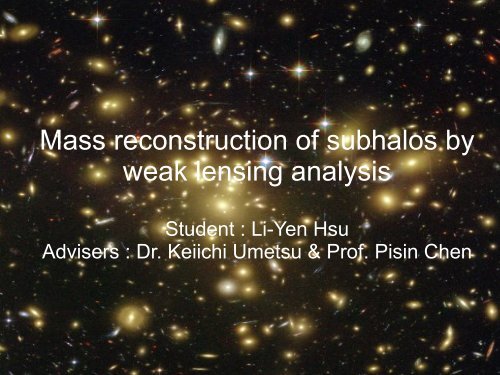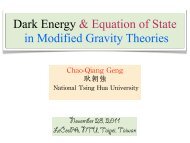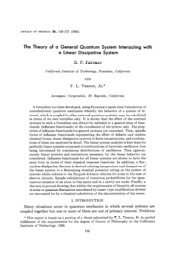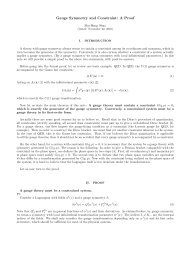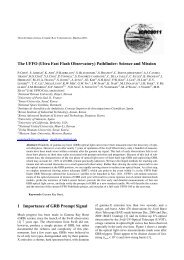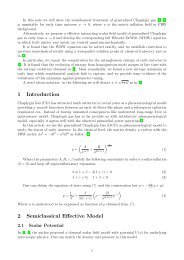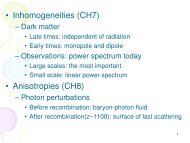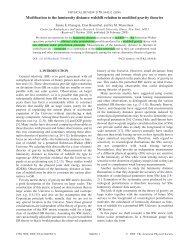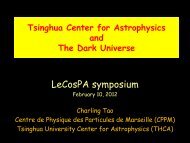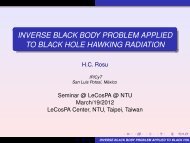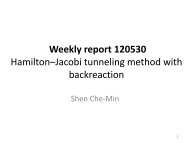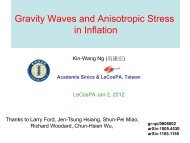Mass reconstruction of subhalos by weak lensing analysis
Mass reconstruction of subhalos by weak lensing analysis
Mass reconstruction of subhalos by weak lensing analysis
Create successful ePaper yourself
Turn your PDF publications into a flip-book with our unique Google optimized e-Paper software.
<strong>Mass</strong> <strong>reconstruction</strong> <strong>of</strong> <strong>subhalos</strong> <strong>by</strong><br />
<strong>weak</strong> <strong>lensing</strong> <strong>analysis</strong><br />
Student : Li-Yen Hsu<br />
Advisers : Dr. Keiichi Umetsu & Pr<strong>of</strong>. Pisin Chen
Outlines<br />
● Introduction – Weak gravitational <strong>lensing</strong><br />
● galaxy-galaxy <strong>lensing</strong><br />
● Strategy<br />
● Results<br />
● Summery
Lens equation (cluster gravitational <strong>lensing</strong>)
Lensing Jacobian matrix, Convergence &<br />
Shear<br />
● Lensing Jacobian matrix : image -> source<br />
where<br />
with the formula <strong>of</strong> the <strong>lensing</strong> effective potential:
Effect <strong>of</strong> convergence & shear<br />
● Convergence<br />
=> size<br />
● Shear<br />
=> shape
Weak Lensing Distortion Observables<br />
● Ellipticity (spin-2):
Weak Lensing Distortion Observables<br />
● Ellipticity in turns <strong>of</strong> quadrupole moments <strong>of</strong> the surface<br />
brightness distribution<br />
● Ellipticity transforms under the lens mapping :<br />
● In the <strong>weak</strong> <strong>lensing</strong> limit :<br />
assuming that the sources are randomly oriented :
Lensing distortion pr<strong>of</strong>iles<br />
● The tangential and cross-component shears<br />
rotate the basis axis :<br />
=><br />
(The ref. point is <strong>of</strong>ten taken to be the cluster center)<br />
● Statistics<br />
● Comparing observed tangential shear pr<strong>of</strong>iles with models
Lensing distortion pr<strong>of</strong>iles<br />
● Fitting the model to the distortion pr<strong>of</strong>iles
Galaxy-galaxy <strong>lensing</strong><br />
● Assumption: Each Cluster's galaxy resides in a<br />
subhalo<br />
● Background galaxies are lensed <strong>by</strong> galaxysized<br />
halos<br />
● Galaxy-galaxy <strong>lensing</strong> requires that lenses must<br />
be stacked in order to enhance S/N ratio<br />
=> expect to get <strong>of</strong> the stacking <strong>subhalos</strong>
Strategy<br />
● Averaging out the smooth<br />
part induce <strong>by</strong> the cluster<br />
potential In the polar<br />
coordinates
● The aperture <strong>of</strong> each<br />
target subhalo should<br />
not include another<br />
subhalo.<br />
● Treating <strong>subhalos</strong> as<br />
point sources<br />
=> Inverse-square law<br />
Aperture
Simulation-N body data<br />
● Binning the sample <strong>of</strong> subhals into 3 mass bins
Simulation-N body data<br />
● Binning the field into 3 radial bins
Working on Cl0024+1654 data (z=0.395)<br />
● Binning the field and the sample <strong>of</strong> cluster galaxies into a<br />
few radial bins or a few luminosity bins<br />
● Using the R-band for the luminosity (or flux, magnitude)<br />
measurements<br />
● Trying to avoid those region that shear induced <strong>by</strong> the host<br />
halo varies too much as r changes<br />
● We expect to see a tendency <strong>of</strong> increasing M with<br />
increasing luminosity, or increasing distance from the<br />
cluster's center due to dynamics.
Stacking all the lenses without bins
● <strong>Mass</strong> <strong>reconstruction</strong><br />
3 radial bins
1 st R bin
2 nd R bin
3 rd R bin
● <strong>Mass</strong> <strong>reconstruction</strong><br />
3 luminosity bins
1 st L bin
2 nd L bin
3 rd L bin
Summery<br />
● It is a model dependent (point source) method.<br />
● It is a pure <strong>lensing</strong> <strong>analysis</strong> without scaling<br />
relations.<br />
● The mass <strong>of</strong> <strong>subhalos</strong> should increase as the<br />
luminosity or radius increases.<br />
● We must try more strategy to improve S/N ratio.<br />
● How to subtract the cluster's potential<br />
contribution exactly is still a problem.
● Keiichi Umetsu<br />
References<br />
lecture:“Cluster Weak gravitational <strong>lensing</strong>”<br />
arXiv:0908.0069v2 [astro-ph.CO] 11 Aug 2009<br />
arXiv:astro-ph/0004400v2 29 Apr 2000<br />
● Peter Schneider & Carolin Seitz, astro-ph/9407032 12 Jul 1994<br />
● Priyamvada Natarajan, arXiv:astro-ph/9609008v2 24 Apr 1997<br />
● Priyamvada Natarajan, arXiv:0711.4587v2 [astro-ph] 5 Nov 2008<br />
● Dodelson “Modern Cosmology”


